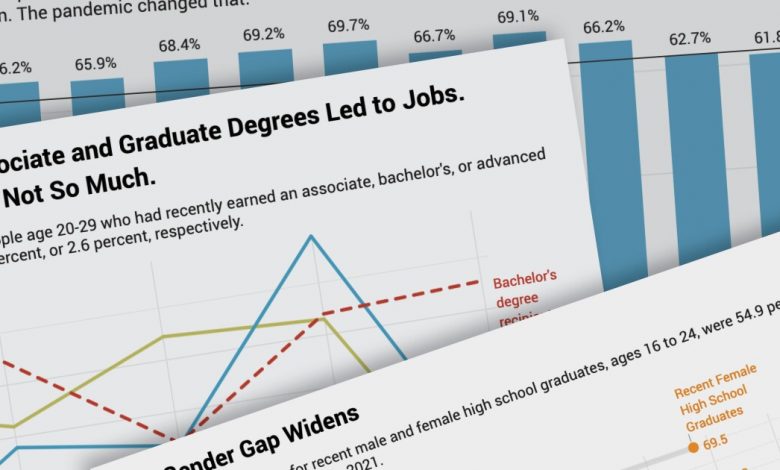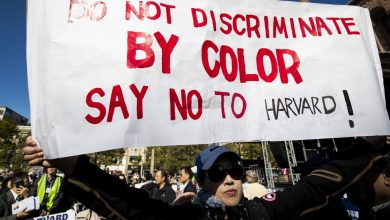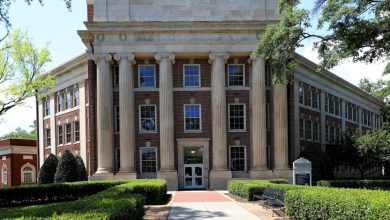3 Things We Learned From the Latest Federal Employment and Enrollment Report

America’s colleges and universities last October enrolled the smallest share of graduating high-school seniors in over a decade.
According to new estimates from the Bureau of Labor Statistics, 61.8 percent of the Class of 2021 elected to attend college as of October 2021, down slightly from 62.7 percent for the Class of 2020. Prior to 2020, higher ed could typically count on at least 65 percent of each year’s cohort of graduating high schoolers to seek out a postsecondary education. Covid, though, broke that streak.
Those data points were in a new report from BLS on the enrollment and work activity of recent high-school and college graduates. Here are three other items of interest from this latest report from the government:
Women already attended college at higher rates than men. The pandemic widened that gap.
There is no shortage of studies and reports dissecting why for decades young women have attended college at higher rates than similarly situated men. As recently as October 2017, a double-digit canyon separated female and male recent high-school graduates turned college freshmen, in terms of their rates of college attendance (71.7 percent and 61.1 percent, respectively).
In the first year of the pandemic, both cohorts saw college attendance shrink by around three percentage points relative to 2019 — for men, a decline of 62.0 percent to 59.3 percent; for women, 69.8 percent to 66.2 percent.
While college attendance among women who recently graduated high school rebounded to 2019 levels last October, attendance among men continued to slide. BLS estimated that the gap in rates of college attendance between men and women who’d just graduated from high school had widened to 14.6 percentage points last year (54.9 percent and 69.5 percent, respectively).
Just graduated with a bachelor’s degree. Will work for food.
A tighter labor market last fall benefited people who had recently earned associate and advanced degrees. Among 20- to 29-year-olds, the unemployment rate for recent associate-degree recipients dropped to 4.5 percent in October 2021, a stark difference from the 15.8 percent recorded a year earlier. It was also an improvement on the unemployment rate of 8.7 percent for this group in 2019.
For newly minted advanced-degree recipients, the news was even better: Only 2.6 percent were counted as unemployed. A year prior, the news had been much grimmer for these graduates. In October 2020, the unemployment rate for recent advanced-degree recipients was 12.6 percent — an improvement from 2019’s unemployment rate of 12.9 percent for the group.
Recent bachelor’s degree recipients, though, were left out in the cold. The unemployment rate for new bachelor’s-degree recipients ticked up to 13.1 percent last fall, eclipsing the 2020 unemployment rate of 12.8 percent recorded for the same set of graduates a year earlier. In 2019, the unemployment rate for this group hovered around 8.8 percent.
The labor-force participation rates for these three groups traced similar trajectories to the unemployment rates, either expanding or remaining steady between 2020 and 2021. The shares of recent associate-degree and bachelor’s-degree recipients who were either employed or actively seeking employment each increased 10 percentage-points between 2020 and 2021. As for recent advanced-degree holders either working or interested in working, the labor-force participation rate held steady in 2020 and 2021 at around 84 percent.
Working and going to school part time? It’s not as popular as it used to be.
Before the pandemic, recent high-school graduates attending college part time generally also elected to work a job. In 2019, for instance, three out of every four part-time freshmen attending college held a job outside of school.
But since 2019, behaviors have shifted. In 2020, the share of recent high-school graduates attending college part time while holding down a job fell to 67.5 percent. And by 2021, only 54 percent of recent college graduates reported working while studying part time.
Of course, the vast majority of new high-school graduates enrolled in college full time, rather than part time: 9 out of every 10 recent high-school graduates, according to BLS.
Source link






